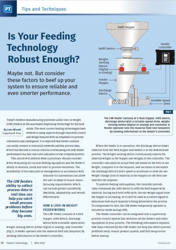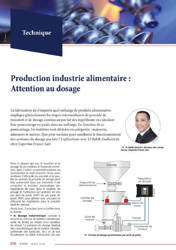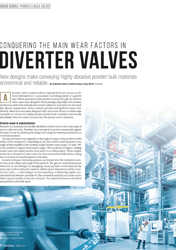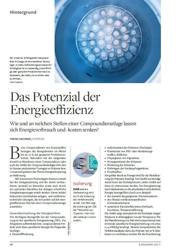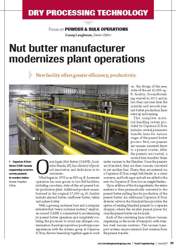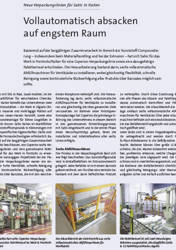Today’s modern manufacturing processes utilize loss-in-weight (LIW) feeders as the automated dispensing technology for dry bulk solids. The most current feeding technologies have evolved in many aspects through improved control and design features with an emphasis on process robustness and intelligence. It is expected that feeder controls can easily connect to industrial networks and key process data, which has become a critical criterion in evaluating not only feeder performance but also real-time indication of the complete process. This article will address what a processor should consider when evaluating his current feeding equipment and the feeder’s ability to monitor, trend and react to process variations.
Publikationen
Hier finden Sie unsere technischen Fachartikel und Publikationen.
Alle Veröffentlichungen anzeigen
-
Is Your Feeding Technology Robust Enough?
Plastics Technology
-
Production industrie alimentaire : Attention au dosage (in French)
Infovrac N°225 - Mars 2020
La fabrication de n'importe quel mélange de produits alimentaires implique généralement les étapes intermédiaires de procédé de transfert et de dosage continu ou par lot des ingrédients en calculant leur pourcentage en poids dans un mélange. En fonction de ce pourcentage, les matière sont divisées en catégories : majeures, mineures et micros. Que peut-on faire pour améliorer le fonctionnement des systèmes de dosage par lots?
-

Chemical Processing E-Handbook: Succeed with Solids
Chemical Processing
In our article about solids processes from Mike Plant, Coperion K-Tron UK, you can read more about our smart feeders that enhance detergent-making process - New facility benefits from process controls and equipment that optimize production.
Download the ebook here
-
Haariges Problem überzeugend gelöst
CHEMIE TECHNIK, Ausgabe März 2019
Artikel in der CHEMIE TECHNIK, Ausgabe März 2019, über den Horizontaler Fließbettsichter HFS, der Kunststoffgranulat von Staub und Engelshaar reinigt.
-
„Genauigkeit von einem Moment zum nächsten“
CHEMIE TECHNIK, Ausgabe Januar/Februar 2019
Interview in der CHEMIE TECHNIK mit Jay Daniel, Coperion K-Tron, zur Dosiertechnik in kontinuierlicher Produktion
-
Controlling upstream and downstream influences on loss-in-weight feeders
Powder Bulk Engineering
Loss-in-weight (LIW) feeder performance is affected by a number of influences, both internal and external to the feeder and feeder process. Understanding the significance of these influences is critical for achieving optimal performance. This article will describe some strategies to help ensure accurate weighinhg with your LIW feeder.
-
Conquering the Main Wear Factors in Diverter Valves
Powder & Bulk Solids
A diverter valve is used to divert material from one source to different destinations in a pneumatic conveying system or a gravity pipe. Pellets, granules or fine powders passing through the diverter valve cause wear along the valve's passage, especially with abrasive products as used in the mineral and cement industries. Examples are raw meal, lime, fly ash, bypass dust, clinker, cement, petcoke and lignite to name a few. Diverter valves that have been designed with main wear factors in mind make it possible to convey even highly abrasive powder bulk materials economically and reliably. They also enjoy a long service life and are easy to maintain.
-
Das Potenzial der Energieeffizienz
K-Magazin 4/2017
Wie und an welchen Stellen einer Compoundieranlage lassen sich Energieverbrauch und -kosten senken?
-
Nut Butter Manufacturer Modernizes Plant Operations
Food Engineering
The complete material handling system provided by Coperion K-Tron includes several pneumatic transfer lines for various stages of the peanut butter process. First, raw peanuts are vacuum conveyed direct to a peanut roaster. After the peanuts are roasted, a second line transfers them under vacuum to the blancher. Once the peanuts are blanched, they are then vacuum conveyed to yet another line. There, they are metered via a Coperion K-Tron weigh belt feeder to a screw conveyor, and both sugar and salt are added to the nuts via Coperion K-Tron loss-in-weight feeders.
-
Vollautomatisch absacken auf engstem Raum
cav chemie anlagen verfahren 5/2017
Basierend auf der langjährigen Zusammenarbeit im Bereich der Kunststoff-Compoundierung – insbesondere beim Materialhandling und bei der Extrusion – hat sich Sabic für das Werk in Pontirolo/Italien für eine Coperion-Verpackungslinie sowie eine dazugehörige Palettierinsel entschieden.
